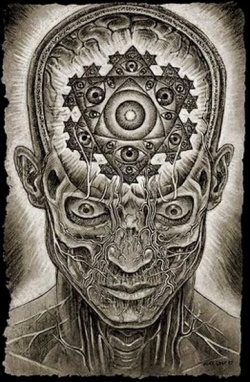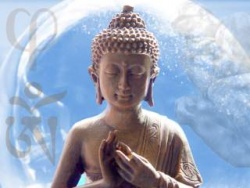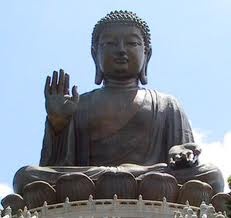Difference between revisions of "Different views of emptiness"
| Line 11: | Line 11: | ||
What both [[views]] have in common is that they both accept that there can be no known [[universe]] outside of the [[mind]] that [[knows]] it. A [[universe]] that is not known to the [[mind]] that is us is not an [[object]] of [[knowledge]] for us. | What both [[views]] have in common is that they both accept that there can be no known [[universe]] outside of the [[mind]] that [[knows]] it. A [[universe]] that is not known to the [[mind]] that is us is not an [[object]] of [[knowledge]] for us. | ||
| − | It is tempting to think that our [[universe]] is out there and our [[mind]] is inside it and somehow reaches out to the [[universe]] to {{Wiki|touch}} it and [[know]] it. But however hard one tries to find a point of [[contact]] – however minute you go, however much you push the boundary of what is inside to find a place where it becomes pervious to what is outside – you never find such a boundary. The only way to go is to drop the [[idea]] that there is a boundary and then you have the so called [[objective]] [[universe]] somehow [[inseparable]] from what we think of as the subjective [[mind]] that [[knows]] and [[experiences]] it. The implications of this for [[understanding]] the [[nature of mind]] and the [[nature]] of the [[universe]] are massive, shocking even. | + | It is tempting to think that our [[universe]] is out there and our [[mind]] is inside it and somehow reaches out to the [[universe]] to {{Wiki|touch}} it and [[know]] it. But however hard one tries to find a point of [[contact]] – however minute you go, however much you push the boundary of what is inside to find a place where it becomes pervious to what is outside – you never find such a boundary. The only way to go is to drop the [[idea]] that there is a boundary and then you have the so called [[objective]] [[universe]] somehow [[inseparable]] from what we think of as the [[subjective]] [[mind]] that [[knows]] and [[experiences]] it. The implications of this for [[understanding]] the [[nature of mind]] and the [[nature]] of the [[universe]] are massive, shocking even. |
[[File:Int phil.jpg|thumb|250px|]] | [[File:Int phil.jpg|thumb|250px|]] | ||
| − | The {{Wiki|temptation}} is to try to build a {{Wiki|theory}} out of this so that you can somehow [[grasp]] it as an [[idea]] and then believe in it. But whenever we do that we end up trying to construct a [[universe]] that is measurable and that can be divided into smaller and smaller {{Wiki|particles}} – and divide [[experience]] up into smaller and smaller moments of [[time]] and somehow it never quite works. You get problems like where does one moment end and another begin. Is there a moment in between the two and if there is does it begin and end, and if so is there a moment between, and so on and so on. There are all sorts of problems like that and this is where you are beginning to rub against a whole different possibility – maybe the whole model is completely wrong. | + | The {{Wiki|temptation}} is to try [[to build]] a {{Wiki|theory}} out of this so that you can somehow [[grasp]] it as an [[idea]] and then believe in it. But whenever we do that we end up trying [[to construct]] a [[universe]] that is measurable and that can be divided into smaller and smaller {{Wiki|particles}} – and divide [[experience]] up into smaller and smaller moments of [[time]] and somehow it never quite works. You get problems like where does one [[moment]] end and another begin. Is there a [[moment]] in between the two and if there is does it begin and end, and if so is there a [[moment]] between, and so on and so on. There are all sorts of problems like that and this is where you are beginning to rub against a whole different possibility – maybe the whole model is completely wrong. |
The [[reason]] these problems keep [[arising]] is because the whole way of [[thinking]] and the whole [[idea]] of how we [[know]] at all is wrong. Our whole [[idea]] of the [[nature]] of [[reality]] is wrong – and that is the point, it’s an [[idea]] and the [[idea]] cannot be [[reality]]. [[Reality]] is not an [[idea]] so all [[ideas]] are just analogies or fingers pointing at [[reality]]. [[Reality]] itself is beyond [[ideas]] and we [[know]] it in another way. Now you are talking about [[Shentong]]. | The [[reason]] these problems keep [[arising]] is because the whole way of [[thinking]] and the whole [[idea]] of how we [[know]] at all is wrong. Our whole [[idea]] of the [[nature]] of [[reality]] is wrong – and that is the point, it’s an [[idea]] and the [[idea]] cannot be [[reality]]. [[Reality]] is not an [[idea]] so all [[ideas]] are just analogies or fingers pointing at [[reality]]. [[Reality]] itself is beyond [[ideas]] and we [[know]] it in another way. Now you are talking about [[Shentong]]. | ||
| − | You could say the big [[difference]] between the [[Chittamatra]] and [[Shentong]] is that the [[Chittamatra]] [[view]] is still trying to think of [[mind]] [[as a stream]] of moments of [[consciousness]] and [[Shentong]] goes beyond that kind of model altogether. It takes a leap into a whole different way of [[knowing]] that is not momentary at all. This is [[inconceivable]] because we cannot conceive of anything that is not in [[time]] and [[space]]. Well we can sort of open out to the possibility but then we just have to let go of our ordinary way of trying to understand things through [[thinking]]. It’s {{Wiki|subtle}} – it’s a fundamental shift in the way we relate to our [[experience]]. | + | You could say the big [[difference]] between the [[Chittamatra]] and [[Shentong]] is that the [[Chittamatra]] [[view]] is still trying to think of [[mind]] [[as a stream]] of moments of [[consciousness]] and [[Shentong]] goes beyond that kind of model altogether. It takes a leap into a whole different way of [[knowing]] that is not momentary at all. This is [[inconceivable]] because we cannot [[conceive]] of anything that is not in [[time]] and [[space]]. Well we can sort of open out to the possibility but then we just have to let go of our ordinary way of trying to understand things through [[thinking]]. It’s {{Wiki|subtle}} – it’s a fundamental shift in the way we relate to our [[experience]]. |
[[File:8a2f8 l.jpg|thumb|250px|]] | [[File:8a2f8 l.jpg|thumb|250px|]] | ||
*[[Chittamatra]]: ‘[[Mind-only]]’ (also [[Vijnanavada]], [[Consciousness]] school‚ and [[Yogachara]], Practice of [[yoga]]). A [[Mahayana]] [[tradition]] founded by [[Asanga]] in the fourth century. Central [[doctrine]]: observing selves and observed external [[objects]] are [[illusory]] {{Wiki|projections}} of a number of interconnected [[mindstreams]]. [[Chittamatrins]] gave extensive descriptions of [[mind]], the [[world]], [[meditation]] and the [[path]]. | *[[Chittamatra]]: ‘[[Mind-only]]’ (also [[Vijnanavada]], [[Consciousness]] school‚ and [[Yogachara]], Practice of [[yoga]]). A [[Mahayana]] [[tradition]] founded by [[Asanga]] in the fourth century. Central [[doctrine]]: observing selves and observed external [[objects]] are [[illusory]] {{Wiki|projections}} of a number of interconnected [[mindstreams]]. [[Chittamatrins]] gave extensive descriptions of [[mind]], the [[world]], [[meditation]] and the [[path]]. | ||
| − | **[[Shentong]]: ‘[[Emptiness]] of other’ ([[Reality]] is [[empty]] of all that is not itself, but is not [[empty]] of itself, as it could be understood by some [[Rangtong]] (‘[[Emptiness]] of [[self]]’), interpretations; also [[Reality]] is impossible to know by our usual way of [[thinking]], it requires a fundamentally different kind of [[knowing]] ˆ [[non-conceptual]] [[Wisdom]] [[Mind]], [[non-dual]] [[Jnana]], reached through [[faith]] and [[meditation]]). [[Shentong]] [[view]] is an important aspect of [[Lama]] Shenpen’s [[teaching]]. For an in-depth analysis of [[Shentong]] [[view]] and finer points of Shentong/Rangtong {{Wiki|distinctions}} see ‘The [[Buddha]] Within‘, [[Lama]] Shenpen’s doctoral {{Wiki|thesis}} (S. K. Hookham, pub. Sri Satguru Publications, {{Wiki|Delhi}}, 1991). | + | **[[Shentong]]: ‘[[Emptiness]] of other’ ([[Reality]] is [[empty]] of all that is not itself, but is not [[empty]] of itself, as it could be understood by some [[Rangtong]] (‘[[Emptiness]] of [[self]]’), interpretations; also [[Reality]] is impossible to know by our usual way of [[thinking]], it requires a fundamentally different kind of [[knowing]] ˆ [[non-conceptual]] [[Wisdom]] [[Mind]], [[non-dual]] [[Jnana]], reached through [[faith]] and [[meditation]]). [[Shentong]] [[view]] is an important aspect of [[Lama]] Shenpen’s [[teaching]]. For an in-depth analysis of [[Shentong]] [[view]] and finer points of Shentong/Rangtong {{Wiki|distinctions}} see ‘The [[Buddha]] Within‘, [[Lama]] Shenpen’s doctoral {{Wiki|thesis}} ([[S. K. Hookham]], pub. Sri [[Satguru]] Publications, {{Wiki|Delhi}}, 1991). |
</poem> | </poem> | ||
{{R}} | {{R}} | ||
Revision as of 22:47, 19 March 2015
Summary: Emptiness, that is the idea that the world is not the solid, unchanging thing it appears to be, is a key Buddhist concept. It has been interpreted in different ways, and in this technical discussion Lama Shenpen explains the difference between two traditional views, known as Chittamatra* and Shentong**. It is a very complex and deep subject but it is possible to get a flavour of it from this exchange.
A student asks:
Can you please explain the difference difference between the Chittamatra view and the Shentong view?
Lama Shenpen replies:
What both views have in common is that they both accept that there can be no known universe outside of the mind that knows it. A universe that is not known to the mind that is us is not an object of knowledge for us.
It is tempting to think that our universe is out there and our mind is inside it and somehow reaches out to the universe to touch it and know it. But however hard one tries to find a point of contact – however minute you go, however much you push the boundary of what is inside to find a place where it becomes pervious to what is outside – you never find such a boundary. The only way to go is to drop the idea that there is a boundary and then you have the so called objective universe somehow inseparable from what we think of as the subjective mind that knows and experiences it. The implications of this for understanding the nature of mind and the nature of the universe are massive, shocking even.
The temptation is to try to build a theory out of this so that you can somehow grasp it as an idea and then believe in it. But whenever we do that we end up trying to construct a universe that is measurable and that can be divided into smaller and smaller particles – and divide experience up into smaller and smaller moments of time and somehow it never quite works. You get problems like where does one moment end and another begin. Is there a moment in between the two and if there is does it begin and end, and if so is there a moment between, and so on and so on. There are all sorts of problems like that and this is where you are beginning to rub against a whole different possibility – maybe the whole model is completely wrong.
The reason these problems keep arising is because the whole way of thinking and the whole idea of how we know at all is wrong. Our whole idea of the nature of reality is wrong – and that is the point, it’s an idea and the idea cannot be reality. Reality is not an idea so all ideas are just analogies or fingers pointing at reality. Reality itself is beyond ideas and we know it in another way. Now you are talking about Shentong.
You could say the big difference between the Chittamatra and Shentong is that the Chittamatra view is still trying to think of mind as a stream of moments of consciousness and Shentong goes beyond that kind of model altogether. It takes a leap into a whole different way of knowing that is not momentary at all. This is inconceivable because we cannot conceive of anything that is not in time and space. Well we can sort of open out to the possibility but then we just have to let go of our ordinary way of trying to understand things through thinking. It’s subtle – it’s a fundamental shift in the way we relate to our experience.
- Chittamatra: ‘Mind-only’ (also Vijnanavada, Consciousness school‚ and Yogachara, Practice of yoga). A Mahayana tradition founded by Asanga in the fourth century. Central doctrine: observing selves and observed external objects are illusory projections of a number of interconnected mindstreams. Chittamatrins gave extensive descriptions of mind, the world, meditation and the path.
- Shentong: ‘Emptiness of other’ (Reality is empty of all that is not itself, but is not empty of itself, as it could be understood by some Rangtong (‘Emptiness of self’), interpretations; also Reality is impossible to know by our usual way of thinking, it requires a fundamentally different kind of knowing ˆ non-conceptual Wisdom Mind, non-dual Jnana, reached through faith and meditation). Shentong view is an important aspect of Lama Shenpen’s teaching. For an in-depth analysis of Shentong view and finer points of Shentong/Rangtong distinctions see ‘The Buddha Within‘, Lama Shenpen’s doctoral thesis (S. K. Hookham, pub. Sri Satguru Publications, Delhi, 1991).


